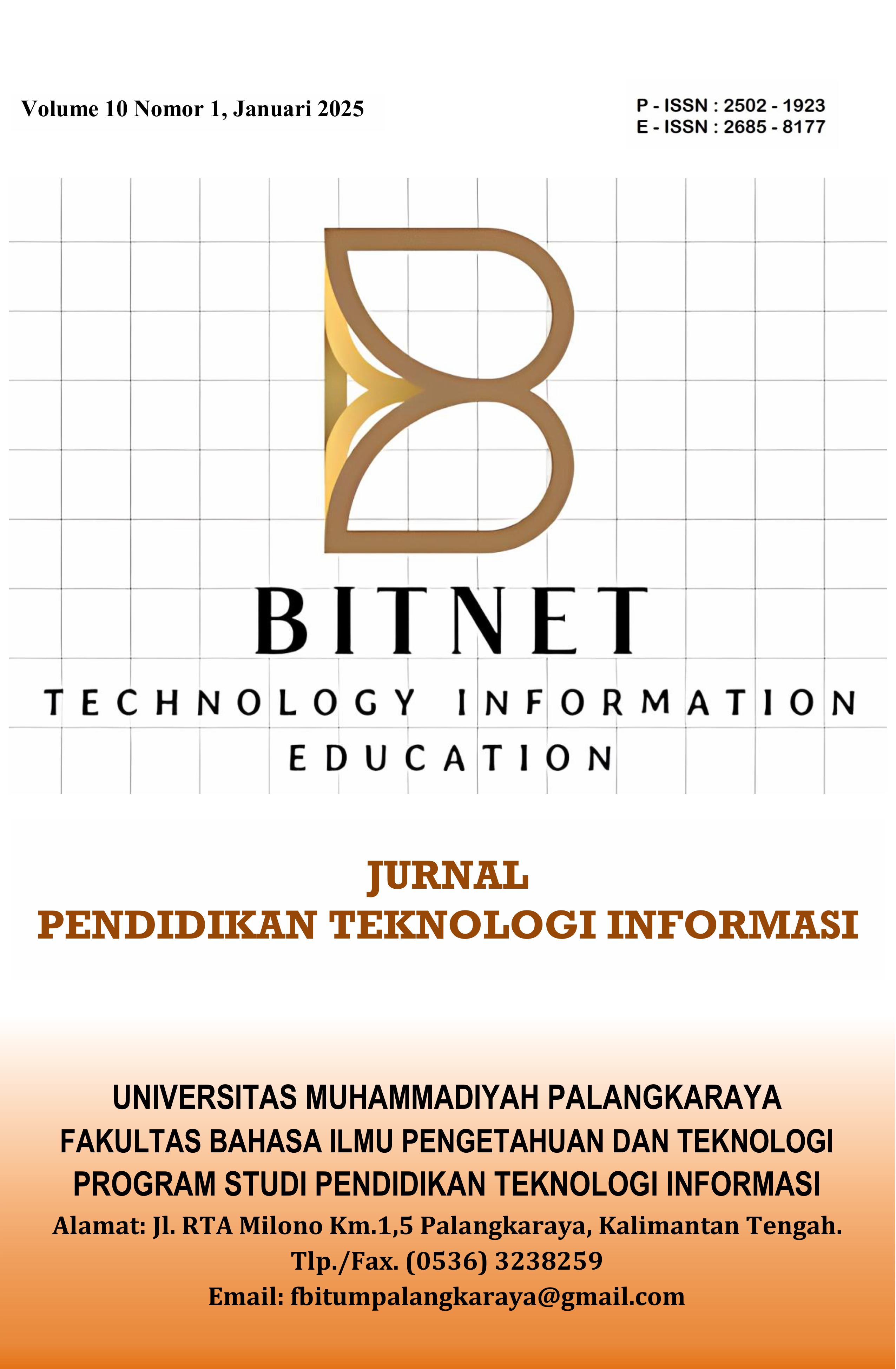Enhancing Accessibility for Disabled Students through Video-Based Learning and Sign Language
DOI:
https://doi.org/10.33084/bitnet.v10i1.8534Keywords:
Inclusive education, Assistive technology, Sign language videos, Accessibility, Higher educationAbstract
This study focuses on addressing the accessibility challenges faced by students with disabilities in higher education by integrating sign language videos with PowerPoint presentations. The objective is to improve learning outcomes and inclusivity, particularly for students with hearing impairments. Using the ADDIE (Analysis, Design, Development, Implementation, and Evaluation) instructional model, the research developed a video-based learning system tailored to the needs of disabled students. Data were collected from students at faculty of business and informatics, palangkaraya muhammadiyah university. Findings reveal significant improvements in accessibility, engagement, and comprehension, with a 38% increase in material access and a 31% improvement in understanding complex concepts. The study concludes that incorporating sign language into educational content not only facilitates better learning outcomes but also promotes active student participation. This research highlights the potential for future development of assistive technologies to create inclusive learning environments in higher education.
Downloads
References
REFERENCES
Amangeldy, N., Kudubayeva, S., Kassymova, A., Karipzhanova, A., Razakhova, B., & Kuralov, S. (2022). Sign Language Recognition Method Based on Palm Definition Model and Multiple Classification. Sensors, 22(17), 1–20. https://doi.org/10.3390/s22176621
Barros, G., Correia, W., & Teixeira, J. M. (2023). Towards the Effectiveness of 3D Printing on Tactile Content Creation for Visually Impaired Users. Polymers, 15(9), 1–23. https://doi.org/10.3390/polym15092180
Bhavya, B., Chen, S., Zhang, Z., Li, W., Zhai, C., Angrave, L., & Huang, Y. (2022). Exploring collaborative caption editing to augment video-based learning. Educational Technology Research and Development, 70(5), 1755–1779. https://doi.org/10.1007/s11423-022-10137-5
Cañete, R., & Peralta, E. (2022). Assistive Technology to Improve Collaboration in Children with ASD: State-of-the-Art and Future Challenges in the Smart Products Sector. Sensors, 22(21). https://doi.org/10.3390/s22218321
Edwards, M., Poed, S., Al-Nawab, H., & Penna, O. (2022). Academic accommodations for university students living with disability and the potential of universal design to address their needs. Higher Education, 84(4), 779–799. https://doi.org/10.1007/s10734-021-00800-w
Gallagher, A. L., Murphy, R., Fitzgerald, J., Murphy, C. A., & Law, J. (2023). Exploring the acceptability, feasibility, and appropriateness of a communication-friendly classroom tool for use in Irish schools: A qualitative inquiry. PLoS ONE, 18(6 June), 1–22. https://doi.org/10.1371/journal.pone.0287471
Kim, J. Y., & Fienup, D. M. (2022). Increasing Access to Online Learning for Students With Disabilities During the COVID-19 Pandemic. Journal of Special Education, 55(4), 213–221. https://doi.org/10.1177/0022466921998067
Lawlis, T., Mawer, T., Andrew, L., & Bevitt, T. (2024). Challenges to delivering university health-based work-integrated learning to students with a disability: a scoping review. Higher Education Research and Development, 43(1), 149–165. https://doi.org/10.1080/07294360.2023.2228209
Liddle, J. (2023). Considering inclusion in digital technology: An occupational therapy role and responsibility. Australian Occupational Therapy Journal, 70(2), 157–158. https://doi.org/10.1111/1440-1630.12867
Luangrungruang, T., & Kokaew, U. (2022). Adapting Fleming-Type Learning Style Classifications to Deaf Student Behavior. Sustainability (Switzerland), 14(8). https://doi.org/10.3390/su14084799
MaćKowski, M., Brzoza, P., Kawulok, M., Meisel, R., & Spinczyk, D. (2023). Multimodal Presentation of Interactive Audio-Tactile Graphics Supporting the Perception of Visual Information by Blind People. ACM Transactions on Multimedia Computing, Communications and Applications, 19(5 s). https://doi.org/10.1145/3586076
Mateos-Sanchez, M., Melo, A. C., Blanco, L. S., & García, A. M. F. (2022). Chatbot, as Educational and Inclusive Tool for People with Intellectual Disabilities. Sustainability (Switzerland), 14(3). https://doi.org/10.3390/su14031520
Micsinszki, S. K., Tanel, N. L., Kowal, J., King, G., Menna-Dack, D., Chu, A., & Phoenix, M. (2022). Codesigning simulations and analyzing the process to ascertain principles of authentic and meaningful research engagement in childhood disability research. Research Involvement and Engagement, 8(1), 1–14. https://doi.org/10.1186/s40900-022-00398-y
Müller, M., Otero, N., & Milrad, M. (2024). Guiding the design and implementation of interactive public displays in educational settings. In Journal of Computers in Education (Vol. 11, Issue 3). Springer Berlin Heidelberg. https://doi.org/10.1007/s40692-023-00280-0
Officer, E., Johnson, M., Blickwedel, J., Reynolds, A., Pearse, R., Pearse, J., & Basu, A. P. (2023). Evaluation of the Training in Early Detection for Early Intervention (TEDEI) e-learning course using Kirkpatrick’s method. BMC Medical Education, 23(1), 1–10. https://doi.org/10.1186/s12909-023-04113-7
Shea, K., St-Cyr, O., & Chau, T. (2021). Ecological Design of an Augmentative and Alternative Communication Device Interface. Journal of Cognitive Engineering and Decision Making, 15(4), 175–197. https://doi.org/10.1177/15553434211029530
Tai, J. H. M., Dollinger, M., Ajjawi, R., Jorre de St Jorre, T., Krattli, S., McCarthy, D., & Prezioso, D. (2023). Designing assessment for inclusion: an exploration of diverse students’ assessment experiences. Assessment and Evaluation in Higher Education, 48(3), 403–417. https://doi.org/10.1080/02602938.2022.2082373
Vlcek, S., & Somerton, M. (2023). Collaborative engagement between stakeholders in the education of Australian students with disability: a scoping review. International Journal of Inclusive Education, 0(0), 1–18. https://doi.org/10.1080/13603116.2023.2216693
Downloads
Published
How to Cite
Issue
Section
License
Copyright (c) 2025 Ahyar junaedi, Putri Irianti Sintaman, Mohamad Rafii, Adhelwis Sekar Risdayanti, Andykha Mujizatryo

This work is licensed under a Creative Commons Attribution-ShareAlike 4.0 International License.
All rights reserved. This publication may be reproduced, stored in a retrieval system, or transmitted in any form or by any means, electronic, mechanical, photocopying, recording.

